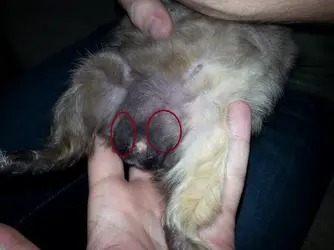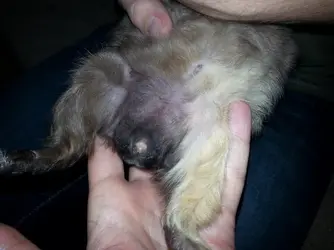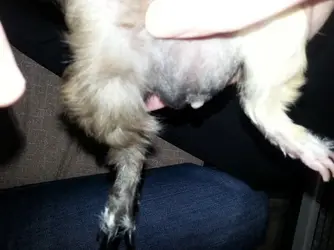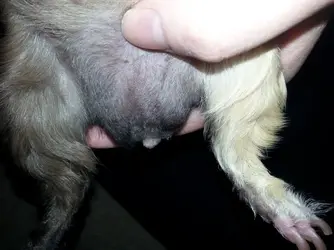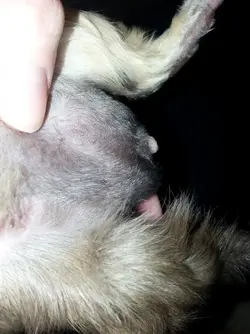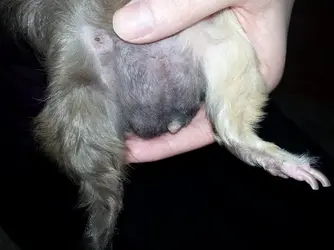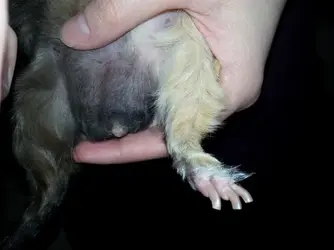RosieMaia
Teenage Guinea Pig
Hello everyone!
I have a 8-month old male guinea pig who was neutered 7 days ago (28 January). The vet who did the surgery is cavy savvy and has excellent reputation. The surgery went fine, and he was active, climbing his cage bars and wheeking for veggies less than 24 hours later. He has been feeling fine ever since, and is eating, pooping and acting normally.
The vet used intradermal stitches (not chromic gut) and then covered the two incisions with surgical glue. He has been on meloxicam (1.5 mg/ml concentration, 0.2 ml once daily) and a 5% enrofloxacin solution at 0.2 ml once daily since. I made sure to keep his cage and bedding very, very clean and purchased sterile hospital bedding (the one used to cover surgical beds), and changed that 4 times daily, microwaved his hay and pellets, and disinfected his water bottle and food bowls twice daily. The only thing that didn't come into his cage sterilized were his veggies. I'm mentioning all these details just to explain why I kind of agree with the vet that an infection is probably not very likely considering the antibiotic plus my obsessive cleaning (I'm usually nor crazy or an OCD cleaner, but was just worried these days).
A few days after the surgery, I noticed some swelling in his groin. The swelling wasn't localized, it looks like the whole area is filled with squishy liquid. He's chocolate brown, so it's a bit hard to tell, but as far as I can see, no redness is visible. I took him to the vet and they excluded a hernia, saying that the technique they used (I don't remember the technical details) make it extremely unlikely, and they did say they don't think it's an abscess, because it doesn't feel like one, and isn't warm nor red. They said they think it's a haematoma, that it should resolve on its own in a few days/weeks, that I shouldn't be concerned, but that I should take him back for a check-up if it hasn't cleared in a week just in case or if he appears to not feel OK. At that point, his stitches were healing very well.
Today, I noticed a bean-sized lump where his right testis had been. It is mobile (i.e. isn't attached either to the skin, or to the soft tissue underneath), isn't red, warm and doesn't appear painful to touch. There's another lump like that on his left side, slightly bigger, but more diffused. I took him to the vet straight away, and she again said it was haematoma. She said that there was some bleeding on the right testis when she removed it, so she had to cauterize a bit more and remove somewhat more from the fatty tissue there and this appears to be where the lump is now. She thinks it's an aseptic inflammation of the soft tissue, a reaction from the surgery with a haematoma, not an abscess, and I should just wait for it to resolve. She said it doesn't feel like there's pus inside, and doesn't want to lance it or aspirate with a needle, because it would cause him unnecessary stress. She did ask me to continue with the meloxicam for another week for its anti-inflammatory properties, and to use enrofloxacin for 10 instead of only 7 days just in case (he appears to tolerate both meds very well, hasn't lost weight, hasn't had any diarrhoea and happily takes his probiotics).
The question is: should I return tomorrow an insist on aspirating some fluid to check whether it really is a haematoma, or considering that the guinea pig is OK, should I just wait and see? What concerns me is that no one here or in the other large guinea pig forums ever mentioned heametoma after neutering, and I am worried that the vets may dismiss an abscess as a haematoma. Is it easy to differentiate between an abscess and a haematoma? If yes - how, are tests needed, or can one just palpate the lump and say for sure? I know there are really knowledgeable people here and I'd be so very grateful for any input.
I have a 8-month old male guinea pig who was neutered 7 days ago (28 January). The vet who did the surgery is cavy savvy and has excellent reputation. The surgery went fine, and he was active, climbing his cage bars and wheeking for veggies less than 24 hours later. He has been feeling fine ever since, and is eating, pooping and acting normally.
The vet used intradermal stitches (not chromic gut) and then covered the two incisions with surgical glue. He has been on meloxicam (1.5 mg/ml concentration, 0.2 ml once daily) and a 5% enrofloxacin solution at 0.2 ml once daily since. I made sure to keep his cage and bedding very, very clean and purchased sterile hospital bedding (the one used to cover surgical beds), and changed that 4 times daily, microwaved his hay and pellets, and disinfected his water bottle and food bowls twice daily. The only thing that didn't come into his cage sterilized were his veggies. I'm mentioning all these details just to explain why I kind of agree with the vet that an infection is probably not very likely considering the antibiotic plus my obsessive cleaning (I'm usually nor crazy or an OCD cleaner, but was just worried these days).
A few days after the surgery, I noticed some swelling in his groin. The swelling wasn't localized, it looks like the whole area is filled with squishy liquid. He's chocolate brown, so it's a bit hard to tell, but as far as I can see, no redness is visible. I took him to the vet and they excluded a hernia, saying that the technique they used (I don't remember the technical details) make it extremely unlikely, and they did say they don't think it's an abscess, because it doesn't feel like one, and isn't warm nor red. They said they think it's a haematoma, that it should resolve on its own in a few days/weeks, that I shouldn't be concerned, but that I should take him back for a check-up if it hasn't cleared in a week just in case or if he appears to not feel OK. At that point, his stitches were healing very well.
Today, I noticed a bean-sized lump where his right testis had been. It is mobile (i.e. isn't attached either to the skin, or to the soft tissue underneath), isn't red, warm and doesn't appear painful to touch. There's another lump like that on his left side, slightly bigger, but more diffused. I took him to the vet straight away, and she again said it was haematoma. She said that there was some bleeding on the right testis when she removed it, so she had to cauterize a bit more and remove somewhat more from the fatty tissue there and this appears to be where the lump is now. She thinks it's an aseptic inflammation of the soft tissue, a reaction from the surgery with a haematoma, not an abscess, and I should just wait for it to resolve. She said it doesn't feel like there's pus inside, and doesn't want to lance it or aspirate with a needle, because it would cause him unnecessary stress. She did ask me to continue with the meloxicam for another week for its anti-inflammatory properties, and to use enrofloxacin for 10 instead of only 7 days just in case (he appears to tolerate both meds very well, hasn't lost weight, hasn't had any diarrhoea and happily takes his probiotics).
The question is: should I return tomorrow an insist on aspirating some fluid to check whether it really is a haematoma, or considering that the guinea pig is OK, should I just wait and see? What concerns me is that no one here or in the other large guinea pig forums ever mentioned heametoma after neutering, and I am worried that the vets may dismiss an abscess as a haematoma. Is it easy to differentiate between an abscess and a haematoma? If yes - how, are tests needed, or can one just palpate the lump and say for sure? I know there are really knowledgeable people here and I'd be so very grateful for any input.
